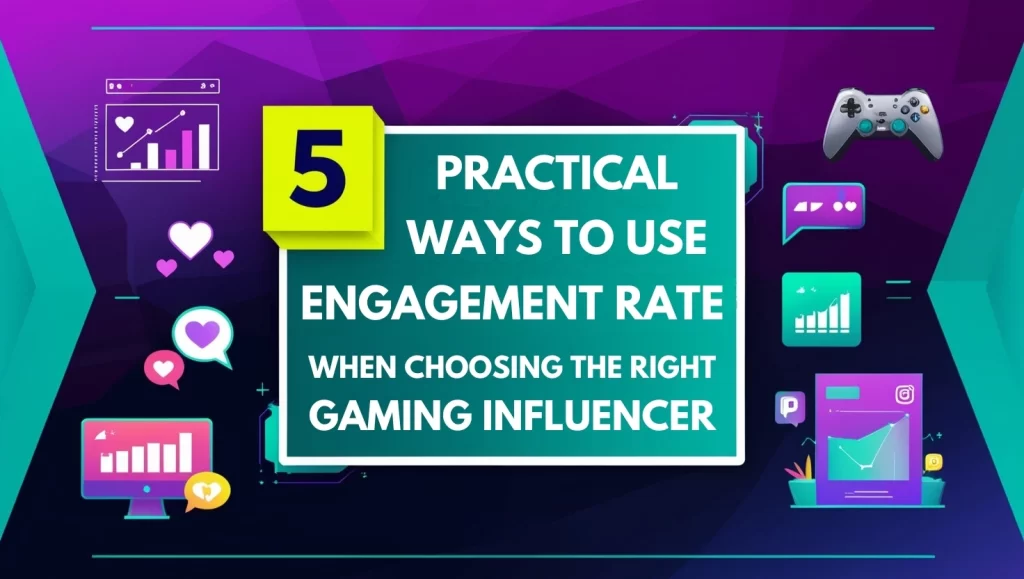If you’re looking to promote your game through influencers, you’re likely eyeing those follower counts like a hawk. But hold up—follower count isn’t the full story. An influencer with 100,000 followers might sound like a big win, but what if only 1% of those followers are truly paying attention? That’s where engagement rate swoops in as the real hero.
In this blog, I’ll share how you can evaluate engagement rates step-by-step to pick the best gaming influencers for your campaigns, plus give you practical ways to use this metric effectively.
1. Spot the Genuine Community Builders
When researching influencers, look at their recent posts and examine the comments section. Are followers genuinely interacting, asking questions, sharing stories, or providing feedback? Or is it filled with generic comments like “Nice!” or “Cool vid!”?
Pro Tip: Focus on influencers whose comments sections have a healthy mix of reactions, suggesting an active community. As a rule of thumb, aim for influencers whose posts show at least 2% of their followers actively commenting or tagging friends.
Why This Works: In gaming, a community-driven influencer has followers who trust their opinions and are more likely to take action, whether it’s buying your product or spreading the word.
2. Use Engagement Rate as a Negotiation Tool
Before reaching out to an influencer, calculate their engagement rate using the formula:
Engagement Rate (%) = (Likes + Comments + Shares) / Total Followers × 100
If an influencer has a lower engagement rate than industry standards (1-3% for gaming influencers), you have leverage. This can be your cue to negotiate rates or seek added value in the collaboration, such as extra social media mentions or a longer campaign period.
Pro Tip: Don’t shy away from asking for engagement insights directly from influencers or their managers. They often have detailed analytics on their audience that can give you a clearer picture of potential ROI.
Why This Works: Understanding and leveraging engagement rates allows you to get the best value for your budget, ensuring you’re paying for real influence, not just a large follower count.
3. Prioritize Micro-Influencers with High Engagement
Don’t just scroll past influencers with smaller followings. Micro-influencers (1,000–50,000 followers) often have higher engagement rates—sometimes over 5%! Use tools like SocialBlade or HypeAuditor to find influencers with a smaller but dedicated gaming audience.
Pro Tip: When working with micro-influencers, explore multi-influencer campaigns. Instead of spending your budget on one big name, collaborate with 3-5 micro-influencers who collectively reach a more engaged and diverse audience.
Why This Works: Micro-influencers often foster strong, loyal communities that actively respond to recommendations, leading to more meaningful interactions and higher conversion rates for your product.
4. A/B Test Different Influencers’ Engagement Impact
When deciding between influencers, run small-scale tests. Select two influencers with similar follower counts but differing engagement rates. Provide them with similar campaign materials and monitor their performance.
Metrics to Track: Measure metrics such as click-through rates (CTR), referral traffic, or conversion rates. Analyze which influencer’s audience not only engages but takes action that aligns with your campaign goals.
Pro Tip: Set up UTM parameters for links shared by each influencer. This way, you can accurately track where the traffic is coming from and directly measure each influencer’s impact.
Why This Works: Testing helps you move beyond assumptions and make data-driven decisions about which influencers generate real, actionable results.
5. Look for Consistency in Engagement, Not Just One-Off Highs
Dive into an influencer’s content history. Use social media analytics tools to track their engagement over time. Look for influencers whose engagement rates have been consistently high across various types of content (livestreams, game reviews, Q&As).
Pro Tip: To identify consistency, track engagement rates for at least their last 10 posts. If their rates vary wildly, it might suggest that their audience’s attention is sporadic or their content strategy is inconsistent. Aim for influencers with steady rates that indicate a reliably engaged audience.
Why This Works: Consistent engagement shows that the influencer’s audience regularly participates, indicating a strong, long-term bond. It’s a sign that their followers are not just casual viewers but committed fans who are more likely to engage with your campaign.
Conclusion:
The engagement rate isn’t just a metric to observe—it’s a tool you can actively use to find, evaluate, and negotiate with the best gaming influencers. By focusing on genuine community interactions, negotiating based on engagement insights, prioritizing high-engagement micro-influencers, A/B testing campaigns, and looking for consistency, you’re setting yourself up for a collaboration that isn’t just a flashy follower count but a real, actionable partnership.
Ready to put these strategies into play? Next time you consider a gaming influencer, go beyond the numbers on their profile. Dive into their engagement rates, watch their community interact, and make data-driven choices that align with your campaign’s success.



